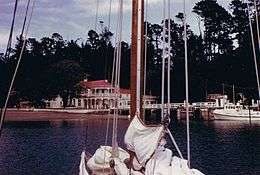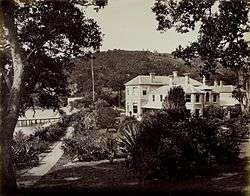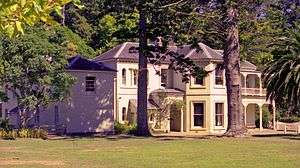Kawau Island
 Mansion House in March, 1967 | |
| Geography | |
|---|---|
| Coordinates | 36°25′24″S 174°50′50″E / 36.4232163°S 174.8472404°E |
| Length | 8 km (5 mi) |
| Width | 5 km (3.1 mi) |
| Administration | |
| Demographics | |
| Population | 70 |
- "Kawau" redirects here. For other uses see Te Kawau, Jason Kawau, and great cormorant (kawau in Māori).
Kawau Island is an island in the Hauraki Gulf, close to the north-eastern coast of the North Island of New Zealand. At its closest point it lies 1.4 km (0.87 mi) off the coast of the North Auckland Peninsula, just south of Tawharanui Peninsula, and about 8 km (5.0 mi) by sea journey from Sandspit Wharf, and shelters Kawau Bay to the north-east of Warkworth. It is 40 km (25 mi) north of Auckland. Mansion House in the Kawau Island Historic Reserve is an important historic tourist attraction. Almost every property on the Island relies on direct access to the sea. There are only two short roads serving settlements at Schoolhouse Bay and South Cove, and most people have private wharves for access to their front door steps.
The island is named after the Māori word for the shag (cormorant) bird.[1]
A regular ferry service operates to the island from Sandspit Wharf on the mainland, as do water taxi services.[2]
Geography
The island is 8 by 5 km (5.0 by 3.1 mi) at its longest axes, and is almost bisected by the long inlet of Bon Accord Harbour which is geologically a "drowned valley".[2] The sheltered location of the bay has made it a favourite stop for yachts for more than a century.[1]
Coordinates: 36°25′24″S 174°50′50″E / 36.4232163°S 174.8472404°E
History

Kawau, though providing little arable land, was well-favoured by Māori for its beautiful surrounding waters, with battles over the island common from the 17th century on.[1]
Copper was mined on the island after discovery in the 1842, in the first years of European ownership.[3] With imported miners and their families from Wales and Cornwall, the mining settlement finally reached a maximum of around 300 people, before problems with shipping and mine flooding (despite the construction of a pump house) closed the mine again in 1855.[1] In 1844/45 the island produced about 7,000 pounds of copper which was about a third of Auckland's exports for that year. The island was bought a few years later by Sir George Grey, Governor of New Zealand, in 1862 as a private retreat. Grey extended the original copper mine manager's house (built 1845) to create the Mansion House, which still stands, and made the surrounding land into a botanical and zoological park, importing many plants and animals.[1] The house changed hands several times after Grey, and decayed increasingly, but has been restored and furnished to its state in the period of Governor Grey and is now in public ownership in the Kawau Island Historic Reserve, administered by the New Zealand Department of Conservation.[1] The reserve is public land and covers 10% of the Island, and includes the old copper mine, believed to be the site of New Zealand's first underground metalliferous mining venture (1844).[2][4][5] The ruins of the mine's pumphouse are registered as a Category I heritage structure.[6]

The island is home to kiwi and two thirds of the entire population of North Island weka. Among the animals that Grey introduced were five species of wallabies. Three of the six introduced wallaby species remain and do considerable damage to the native vegetation,[1] thus harming the habitat for these flightless birds and other native fauna. The wallabies destroy all emerging seedlings which means that the present native trees are the last generation. The usual understorey forest species are absent due to wallaby browsing and in many cases the ground is bare. Possums, also introduced by Grey, destroy mature native trees. The result has been a considerable loss of biodiversity, with bird numbers plummeting due to loss of both food supply and habitat. Even the surrounding marine environment has been severely compromised by silt carried from the bare ground by rainwater.
Grey's wallaby introduction however had some minor indirect benefit in the early 2000s, when species from the island were introduced into Australia's Innes National Park to boost genetic diversity.[1]
Pōhutukawa Trust New Zealand
Pōhutukawa Trust New Zealand was founded in 1992 by Ray Weaver and other private landowners who own 90% of the island, "to rehabilitate the native flora and fauna of Kawau Island". Until then it was considered hopeless to reverse the considerable ecological damage caused by the introduced animal and plant species, and Kawau was said to be of historical rather than botanical importance. The Trust's plan is to eradicate significant animal pests including wallabies and possums, eradicate certain weed species and control others, and enable sustainable land uses in a restored ecological setting of native flora and fauna. The ongoing program is funded by donations and sponsors. Possum numbers have already been greatly reduced and kept at very low numbers since 1985 through sustained control, saving the coastal pōhutukawa tree, a New Zealand icon. The response to pest control work has been increasing native bird numbers, including increased kiwi calls, brown teal, kākā, Kererū, and bellbirds.
After assisting with capturing all of the rare brushtail rock wallabies that could economically be recovered from the private land for relocation to a successful captive breeding program established by Waterfall Springs Conservation Association in Wahroonga, Australia, the Pōhutukawa Trust New Zealand is now humanely eradicating the remaining feral wallabies from the island, to enable ecological restoration (mainly by natural regeneration). An inventory of remaining indigenous plants and forest fragments on the island was compiled in 1996 and is being progressively enhanced to define the remnant resource still available for restoration, and several rare indigenous plant species have been discovered during the process.
Other animal pests the Trust intends to eradicate in stages as resources enable include stoats, feral cats, and ship rats. Exotic plants unpalatable to the wallabies have become serious invasive weeds on the island, and the Trust's plans include eradication or control of these also as part of the ecological restoration process. Kawau is an extreme example of the consequences of exotic animals being brought to a place and ecosystems where they do not belong.
The serious threat of possums to New Zealand's indigenous forest was first positively identified on Kawau by Weaver in 1955. Since then possums have become a major animal pest in New Zealand, compromising both forest health and the country's primary industries. Governor Grey introduced possums to Kawau in 1868-69. The first liberation in New Zealand is believed to have been by Captain Howell at Riverton in the South Island in 1837.
The Pōhutukawa Trust New Zealand received a Green Ribbon Award from the Ministry for the Environment in 2003 "for outstanding leadership and commitment to environmental protection".
About 10% of the island is under the control of the DOC, which tries to keep the protected areas free of invasive pests and animals such as dogs.[7]
See also
References
- 1 2 3 4 5 6 7 8 "The Hauraki Gulf Marine Park, Part 2". Inset to The New Zealand Herald. 3 March 2010. p. 12.
- 1 2 3 "Kawau Island: General Information". Archived from the original on 3 August 2013. Retrieved 28 July 2013.
- ↑ Dunmore, Patricia (ed.) (1977). The Dunmore Book of New Zealand Records. p. 21. ISBN 0-908564-08-2.
- ↑ "Historic Kawau Island". Department of Conservation (New Zealand). Retrieved 28 July 2013.
- ↑ "Copper smelter, Kawau Island". Te Ara: The Encyclopedia of New Zealand. Retrieved 28 July 2013.
- ↑ "Pumphouse Ruins". Register of Historic Places. Heritage New Zealand. Retrieved 25 January 2016.
- ↑ "Dog owner prosecuted over weka killing". The New Zealand Herald. 26 November 2009. Retrieved 5 March 2010.
Further reading
- Russell, Roslyn (Oct 2001). "His island home : Sir George Grey's development of Kawau Island". National Library of Australia News. XII (1): 3–6. Archived from the original on 2012-01-20.
External links
| Wikimedia Commons has media related to Kawau Island. |
- Kawau Island Residents and Property Owners' Association Incorporated
- Pohutukawa Trust New Zealand
- Photographs of Kawau Island held in Auckland Libraries' heritage collections.